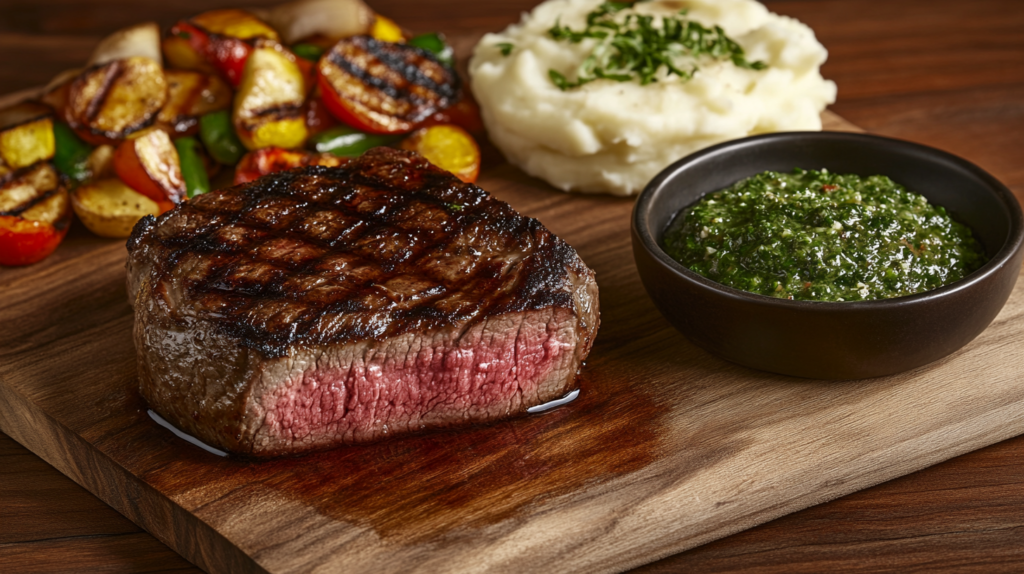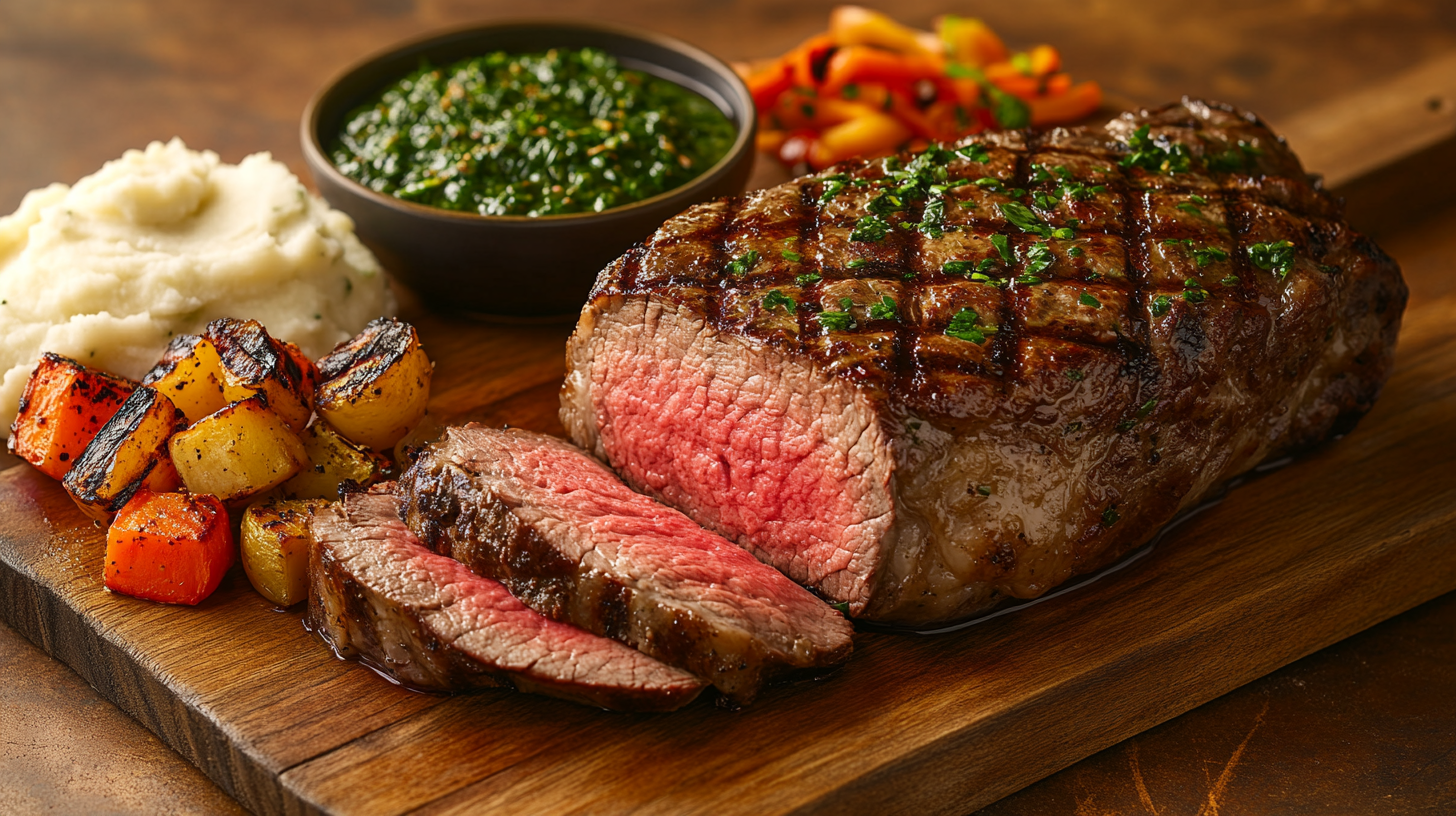Ultimate Guide to Chuck Eye Steak
If you’re a steak lover looking for a cut that gives you all the rich, beefy goodness without breaking the bank, you’ve just hit the jackpot. Enter the chuck eye steak — often dubbed the “poor man’s ribeye.” This hidden gem has been winning hearts (and taste buds) with its incredible flavor, versatility, and affordability. So, grab your apron, and let’s dive into the juicy world of chuck eye steak!
What is Chuck Eye Steak?
You’ve probably heard of ribeye steak, right? But what about its lesser-known cousin, the chuck eye steak? Don’t worry; you’re not alone! Chuck eye steak is one of those cuts that flies under the radar but deserves a standing ovationH3: The Anatomy of Chuck Eye Steak
Chuck eye steak comes from the chuck primal, which is the shoulder area of the cow. Specifically, it’s cut from the upper part of the chuck, right next to the rib primal where ribeye steak is found. Think of chuck eye as the first couple of cuts after the ribeye section ends — it’s like ribeye’s understudy, ready to steal the showH3: How Chuck Eye Differs from Ribeye Steak
While the two cuts share similar marbling and flavor profiles, chuck eye steak isn’t as tender as ribeye. But don’t let that discourage you. With the right cooking methods, chuck eye can be just as melt-in-your-mouth delicious as its pricier counterpart. And hey, who doesn’t love a great steak at a fraction of the cost?
The Unique Flavor and Texture of Chuck Eye Steak
Chuck eye steak is all about bold, beefy flavor. It’s the kind of steak that makes you close your eyes and say, “Wow!” when you take your first bite. The marbling (those little streaks of fat running through the meat) adds richness and juiciness, making every mouthful a celebration of flavor.
Why Chuck Eye is Called the “Poor Man’s Ribeye”
Let’s be real — ribeye is amazing, but it can also be a bit of a budget-buster. Chuck eye steak, on the other hand, delivers similar flavor and satisfaction without making your wallet cry. It’s like finding a designer outfit on clearance — you get all the luxury at a much lower cost.
Nutritional Profile of Chuck Eye Steak
For the health-conscious steak enthusiasts, chuck eye steak is packed with protein, iron, and essential vitamins like B12. It’s also a great source of healthy fats (thanks to that beautiful marbling) that keep you full and satisfied. So, you can indulge guilt-free, knowing you’re getting some solid nutrition with every bite.
How to Choose the Perfect Chuck Eye Steak
Not all steaks are created equal, so let’s talk about how to pick the best chuck eye steak for your next culinary adventure.
Identifying Fresh Chuck Eye in the Market
When shopping for chuck eye steak, look for a cut that has a deep red color and plenty of marbling. The fat should be creamy white, and the meat should have a firm texture. If it looks pale or feels mushy, steer clear — freshness is key to a great steakH3: Selecting the Right Cut for Your Needs
Whether you’re planning to grill, pan-sear, or toss it into a slow cooker, make sure you choose a cut that suits your cooking method. Thicker cuts are perfect for grilling, while thinner ones are ideal for quick cooking methods like pan-searing.
Preparing Chuck Eye Steak: The Basics
Before you even think about turning on the stove or firing up the grill, you need to prep your steak. Trust me, a little preparation goes a long way in making your chuck eye steak shine.
Prepping Tips: Thawing, Trimming, and Seasoning
First things first — if your chuck eye steak is frozen, let it thaw in the fridge overnight. Once it’s thawed, trim any excess fat if needed (but leave some for flavor). As for seasoning, keep it simple with salt and pepper, or go bold with a dry rub or marinade. The choice is yours!
Recommended Marinades for Chuck Eye Steak
Looking to add an extra layer of flavor? Marinades are your best friend. Here’s a quick recipe for a zesty garlic and herb marinade:
“Combine olive oil, minced garlic, fresh rosemary, lemon juice, and a pinch of red pepper flakes. Let your steak soak up the flavors for at least 2 hours (or overnight for maximum impact).”
Marinades not only enhance flavor but also help tenderize the meat, making your chuck eye steak even more irresistible.
Cooking Methods for Chuck Eye Steak
Alright, now that your steak is prepped and ready to go, let’s talk about how to cook it to perfection. Spoiler alert: there’s no one-size-fits-all approach here. It all depends on your taste preferences and available tools.
Pan-Seared Chuck Eye Steak
Pan-searing is a quick and easy way to cook chuck eye steak. Heat a cast-iron skillet over high heat, add a bit of oil, and sear your steak for 3-4 minutes on each side. Don’t forget to baste it with butter and herbs for that restaurant-quality finish. It’s as simple as it is delicious!
Grilling Techniques for Chuck Eye Steak
If you’re a fan of smoky, charred flavors, grilling is the way to go. Preheat your grill to medium-high heat, season your steak, and cook it for 4-5 minutes per side for medium-rare. Remember, a meat thermometer is your best friend here — aim for an internal temperature of 130°F for medium-rare goodness.
Sous Vide: A Game-Changer for Chuck Eye
Feeling fancy? Try sous vide! This method involves vacuum-sealing your steak and cooking it in a water bath at a precise temperature. Once it’s cooked, give it a quick sear in a hot skillet for a perfect crust. It’s like science meets steak, and the results are nothing short of amazing.
Common Problems When Cooking Chuck Eye Steak
Even the best cooks run into problems, so let’s troubleshoot some common issues you might face when cooking chuck eye steak.
Overcooking: How to Avoid Dry Steak
Nobody likes a dry steak, right? To avoid overcooking, keep an eye on your steak’s internal temperature. A meat thermometer is a small investment that can save you from a culinary disaster.
Achieving a Perfect Crust Without Burning
Ah, the elusive perfect crust — crispy, golden-brown, and oh-so-delicious. The trick? High heat and a good sear. Just make sure your skillet or grill is hot enough before you add the steak, and don’t overcrowd the pan. Let it cook undisturbed for a few minutes to develop that beautiful crust.
Flavor Pairings for Chuck Eye Steak
The beauty of chuck eye steak is its versatility. Its rich, beefy flavor pairs beautifully with a variety of sides, sauces, and drinks. If you want to elevate your steak dinner to a restaurant-quality experience, flavor pairings are key. Let’s explore some mouthwatering combinations!
Ideal Sides and Sauces
When it comes to sides, think of hearty and flavorful options to complement the steak. Here are a few classics that never fail:
- Garlic Mashed Potatoes: Creamy, buttery, and infused with roasted garlic, this side dish is like a warm hug for your taste buds.
- Grilled Vegetables: Charred zucchini, bell peppers, and asparagus add a fresh, smoky touch to your meal.
- Creamed Spinach: Rich and velvety, creamed spinach adds a luxurious element that perfectly complements the steak.
For sauces, you can’t go wrong with a dollop of compound butter (like herb or garlic butter) or a classic béarnaise sauce. And for those who love bold flavors, a chimichurri sauce or peppercorn gravy will take your chuck eye steak to the next level.
Wine and Beverage Pairings
Pairing your steak with the right drink is like finding the perfect dance partner. For chuck eye steak, a robust red wine like Cabernet Sauvignon or Malbec works wonders. If wine isn’t your thing, a craft beer with caramel and malty notes (like a brown ale) makes an excellent choice. And for non-alcoholic options, a sparkling water with a splash of lime is refreshing and palate-cleansing.
Chuck Eye Steak Recipes You Must Try
There’s nothing quite like getting creative in the kitchen, especially when steak is involved. Here are three incredible chuck eye steak recipes that will impress your family, friends, and even yourself.
Classic Pan-Seared Chuck Eye with Herb Butter
This recipe is all about simplicity and showcasing the natural flavor of the steak.
Ingredients:
- 2 chuck eye steaks
- Salt and black pepper
- 2 tbsp butter
- 2 garlic cloves, smashed
- Fresh rosemary and thyme
Instructions:
- Season your steaks generously with salt and pepper.
- Heat a cast-iron skillet over high heat and add a drizzle of oil.
- Sear the steaks for 3-4 minutes on each side until a golden crust forms.
- Add butter, garlic, and herbs to the skillet, then baste the steaks with the melted butter for 1-2 minutes.
- Let the steaks rest for 5 minutes before serving. Enjoy the melt-in-your-mouth goodness! 😍
Grilled Chuck Eye with Garlic and Rosemary
This one’s for all the grill masters out there.
Ingredients:
- 2 chuck eye steaks
- 3 garlic cloves, minced
- 2 tbsp olive oil
- 1 tbsp fresh rosemary, chopped
- Salt and pepper to taste
Instructions:
- In a small bowl, mix garlic, olive oil, rosemary, salt, and pepper.
- Rub the mixture all over the steaks and let them marinate for at least 30 minutes.
- Preheat your grill to medium-high heat and oil the grates.
- Grill the steaks for 4-5 minutes per side for medium-rare, or longer if you prefer.
- Let the steaks rest for 5 minutes, then serve with your favorite sides.

Chuck Eye Steak Tacos: A Twist on Tradition
Who doesn’t love tacos? This recipe gives steak night a fun and flavorful twist.
Ingredients:
- 1 chuck eye steak
- 1 tbsp taco seasoning
- 1 tbsp olive oil
- 8 small flour tortillas
- Toppings: avocado, salsa, shredded cheese, and fresh cilantro
Instructions:
- Rub the steak with taco seasoning and olive oil.
- Heat a skillet over medium-high heat and cook the steak for 3-4 minutes on each side.
- Let the steak rest for 5 minutes, then slice it into thin strips.
- Warm the tortillas and assemble the tacos with your favorite toppings. 🌮
Budget-Friendly Alternatives to Ribeye
Let’s face it — ribeye can be pricey. But with chuck eye steak, you don’t have to compromise on flavor or quality. In fact, chuck eye steak is a fantastic budget-friendly alternative, and there are ways to make it taste even more luxurious.
Why Chuck Eye Offers Great Value
Chuck eye steak is one of the most affordable cuts of beef, making it perfect for anyone who loves steak but doesn’t want to splurge. It’s flavorful, juicy, and can hold its own against pricier cuts like ribeye or strip steak. Plus, you can often find it on sale, so stock up when you see a good deal.
Cooking Techniques to Maximize Flavor on a Budget
The secret to making chuck eye steak taste like a million bucks? It’s all in the cooking. Whether you’re grilling, pan-searing, or slow-cooking, make sure to use high heat to lock in the flavors. And don’t forget the importance of resting your steak — this simple step ensures every bite is juicy and tender.
Storing and Reheating Chuck Eye Steak
If you’ve got leftover chuck eye steak (lucky you!), proper storage and reheating are crucial to maintain its flavor and textureH3: How to Properly Store Leftovers
To store leftover steak, wrap it tightly in aluminum foil or place it in an airtight container. Pop it in the fridge, where it’ll stay good for up to 3 days. For longer storage, freeze it in a freezer-safe bag, and it’ll keep for up to 3 months.
Best Practices for Reheating Without Drying Out
Nobody wants a rubbery, dried-out steak. To reheat your chuck eye steak, try these methods:
- Oven Method: Place your steak on a baking sheet, cover it with foil, and heat it in the oven at 250°F until warm.
- Stovetop Method: Add a splash of beef broth or water to a skillet, place the steak in, and cover it with a lid. Heat over low until warm.
- Microwave Method (Last Resort): Use a microwave-safe dish, cover the steak with a damp paper towel, and heat it in short bursts to prevent drying out.
Common Questions About Chuck Eye Steak
We know you might still have a few questions about this incredible cut of meat, so let’s tackle some FAQs.
Is Chuck Eye Steak Good for Grilling?
Absolutely! Chuck eye steak is fantastic for grilling, thanks to its marbling and rich flavor. Just remember to marinate it or season it well, and cook it to your preferred doneness.
How Does Chuck Eye Compare in Tenderness?
While chuck eye steak isn’t as tender as ribeye, it’s still wonderfully juicy and flavorful when cooked properly. Tenderness can also be improved with marinades or by using a meat mallet.
Conclusion: Why Chuck Eye Steak Deserves a Place on Your Plate
Chuck eye steak is the underdog of the steak world, and it’s high time it got the recognition it deserves. Affordable, flavorful, and versatile, this cut proves that you don’t need to spend a fortune to enjoy a truly spectacular steak dinner. So, the next time you’re at the butcher or grocery store, don’t overlook the humble chuck eye — your taste buds (and your wallet) will thank you. 🥩✨
Let me know if you’d like me to add anything else or expand on any section! 😊
The Ultimate Guide to Chuck Eye Steak
If you’re craving a steak dinner but don’t want to splurge on ribeye, the chuck eye steak is your answer. Packed with robust beefy flavor and tender marbling, this cut is perfect for grilling, pan-searing, or slow cooking. Let’s dive into what makes chuck eye steak special, how to cook it, and how to maximize its potential.
What is Chuck Eye Steak?
Chuck eye steak, often referred to as the “poor man’s ribeye,” is a lesser-known cut from the shoulder of the cow. It shares similar characteristics with ribeye but at a fraction of the cost.
The Difference Between Chuck Eye and Ribeye
While ribeye is renowned for its tenderness, chuck eye steak holds its own in flavor. With proper preparation and cooking, you can achieve restaurant-quality results without overspending.
The Flavor Profile of Chuck Eye Steak
Chuck eye boasts a rich, beefy taste that pairs beautifully with hearty sides. Its marbling ensures a juicy, melt-in-your-mouth texture when cooked right.
Preparing Chuck Eye Steak
Proper preparation is the key to turning this affordable cut into a gourmet experience.
Thawing and Seasoning
Start by thawing the steak in the fridge overnight. Season with salt, pepper, or your favorite spice rub. Marinating can also enhance its flavor and tenderness.
Pro Tip: A simple garlic and rosemary marinade can elevate the steak’s natural flavors.
Cooking Methods
- Grilling: For smoky, charred flavors.
- Pan-searing: Ideal for creating a caramelized crust.
- Sous vide: Perfect for precise, even cooking.
For detailed instructions, check out the article on how to cook Delmonico steak perfectly, which provides tips adaptable to chuck eye steak.
Flavor Pairings for Chuck Eye Steak
Pairing the steak with the right sides and drinks enhances your dining experience.
Side Dishes
- Garlic mashed potatoes
- Grilled vegetables
- Creamed spinach
Beverage Pairings
Pair with a robust red wine or a malty craft beer for the ultimate indulgence. For more pairing inspiration, see this guide on what makes bundt cakes special, which discusses complementary flavors for desserts and beyond.
Budget-Friendly Alternative
Chuck eye steak proves that great steak doesn’t have to be expensive. If you’re curious about similar options, you might enjoy reading about the differences between Delmonico and New York strip steak, which explores affordable cuts in depth.
Storing and Reheating
For leftovers, store your chuck eye steak in an airtight container in the fridge for up to 3 days. When reheating, use the oven or a skillet to retain its juicy texture. Avoid the microwave unless absolutely necessary.
Did You Know? Proper storage and reheating techniques can keep your steak as flavorful as the day you cooked it!

